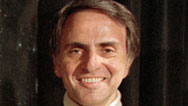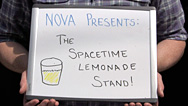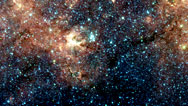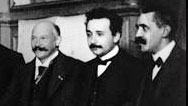
Fabric: The Illusion of Time
The Fabric of the Cosmos, Hour 2: It defines our lives, but what is time really? Have a look into its true nature. Airing July 18, 2012 at 9 pm on PBS Aired July 18, 2012 on PBS
- Originally aired 11.09.11
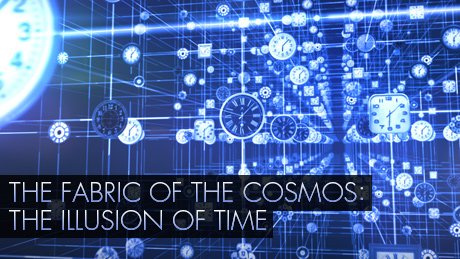
Program Description
Transcript
THE FABRIC OF THE COSMOS: THE ILLUSION OF TIME
PBS Airdate: November 9, 2011
BRIAN GREENE (Columbia University): "Once upon a time…," that magical phrase at the beginning of every good story, but what is the story of "time?"
People say that "time flies," that "time is money," we "waste time," we "kill time," we try to "save time." But what do we really know about time?
Well, like this river, time seems to flow endlessly from one moment to the next. And the flow of time seems to always be in one direction: toward the future. But that may not be right. Discoveries over the last century have shown that much of what we think about time may be nothing more than an illusion. Contrary to everyday experience, time may not flow at all. Our past may not be gone; our future may already exist.
It turns out, time itself can speed up or slow down, and events that we think can unfold in only one direction can also unfold in reverse. But how could this be? How could we be so wrong about something so familiar? And if time isn't what we all think it is, then what is it? Did it have a beginning? Will it have an end? Where did it come from?
JANNA LEVIN (Barnard College/Columbia University): We'd like to corner time as a thing, but it defies that completely by being momentary, by, by only having definitions that harken back to the notion of time itself.
DAVID ALBERT (Barnard College/Columbia University): Time is the thing that everyone knows intimately, until you ask them to tell you about it.
ALAN GUTH (Massachusetts Institute of Technology): "What is time?" is really the $64,000 question to physics.
MAX TEGMARK (Massachusetts Institute of Technology): There's basically no aspect of time which I feel we really fully understand.
BRIAN GREENE: So how do you begin to unlock a mystery as deep and elusive as time? Well, one way is to measure it. And using clocks of all different shapes, sizes and kinds, we've been measuring time with ever-greater accuracy for thousands of years.
The first clock was one that you could say ticks just once a day: the rotating Earth. From the repetition of our planet's daily rotation on its axis, to its yearly orbit around the sun, we have always used the predictable, consistent motion of the earth to measure time.
PETER GALISON (Harvard University): We're always looking for things that repeat over and over again. And that repetition, that cycle of things, forms a clock. That's all time becomes is some repetitive process.
BRIAN GREENE: Measuring the earth's motion with a sundial, we divided the day into hours.
WILLIAM PHILLIPS (National Institute of Standards and Technology): The earth rotates once a day, and we tick off the days by looking at the rising and the setting of the sun. You can subdivide that by making a sundial.
BRIAN GREENE: With the swing of a pendulum, we divided hours into minutes and seconds. With the vibration of a quartz crystal, we improved accuracy to the thousandths of a second. But the National Institute of Standards and Technology, in Colorado, is the place to go if you really want to know what time it is.
STEVE JEFFERTS (National Institute of Standards and Technology): This is U.S. official time. It doesn't get any more accurate than this. Here, they measure time with mind-boggling accuracy using one of the smallest objects in the universe: an atom of a rare metal called cesium.
WILLIAM PHILLIPS: Atoms have a natural frequency. And anything that vibrates, that is giving you repetitive motion, can be a clock. The frequency at which the cesium atom ticks is the official timekeeper for the world.
BRIAN GREENE: When a cesium atom is bombarded with energy, it vibrates, or ticks, giving off pulses of light over 9 billion times a second.
STEVE JEFFERTS: We count the ticks of the cesium atom. And the cesium atom ticks at this 9,192,631,770 ticks in a second.
And so every time you count up to that number, one second has gone by. And you get one second, after one second, after one second, after one second.
WILLIAM PHILLIPS: This is just astounding. My watch gains or loses a second every couple of months. We're talking about clocks that would only gain or lose a second in 100 million years.
PETER GALISON: And that kind of story, where we take one measure of time and replace it with something that we decide is more accurate, has been the constant reform process of physics over hundreds of years.
BRIAN GREENE: But no matter how accurate our clocks have become, time remains a mystery. Clocks can tell us what time it is, but they haven't been able to tell us what time itself is. What is it we're actually measuring?
We may not know what time is, but the experience of the passage of time is a fundamental part of our lives. We're always thinking about time, remembering the past, making plans for the future, living our lives within time's constant tick, tick, tick.
I mean, look around any train station, and you can see how time rules our lives. What may not be so obvious is that the rise of train travel played a key role in one of the most startling discoveries about time.
PORTER (Dramatization): Tickets please, sir.
BRIAN GREENE: (Dramatization) Train running on time?
PORTER (Dramatization): Yes sir.
BRIAN GREENE: (Dramatization) Thank you.
(Narration) In the early days of train travel, time posed a unique problem. Back then, each town set their own particular time. Noon was when the sun was directly overhead, you know, more or less. And what time it was in another city, well, you know, that hardly mattered.
And to complicate things even further, trains would carry the time of the city where they began their journey. So, if I were going from Paris to Geneva, I would be on Paris time the whole way, since that's where I started. But were I going the other direction, from Geneva to Paris, I'd be on Geneva time.
PETER GALISON: And as you began to have more and more train lines crossing, and more and more different times located at that interchange, it became a nightmare of confusion.
BRIAN GREENE: The need to coordinate clocks over great distances became a huge issue, especially when the cities were connected by a single track. And here's where the modern story of time begins: as the need for synchronized clocks became ever more critical, a young physicist named Albert Einstein took a job at the patent office in Bern, Switzerland.
PETER GALISON: It was ringside seat to all of the great inventions of the time. The patents showed how…new and exciting ways to synchronize clocks with the exchange of telegraph signals, clocks that were synchronized by radio waves. All made the synchronization of time and what time was and how it was measured, something immediately important and exciting for Einstein.
BRIAN GREENE: Einstein would soon shake up the world with a radical insight into the nature of time. And these mechanical devices provided unexpected inspiration. Einstein realized that these attempts to synchronize clocks, they were much more than merely creative inventions. Instead, he realized that they were revealing a deep crack in our understanding of time itself.
Most people view time in a pretty simple, straightforward way. Time ticks the same for everyone everywhere. It's a common-sense picture established by the father of modern science, Isaac Newton.
S. JAMES GATES, JR. (University of Maryland): Time, for Isaac Newton, is something that is an immutable property of the universe. Time always changes at the same rate.
BILL PHILLIPS: Time just goes along, and there's really nothing we can do about it.
BRIAN GREENE: Sensible as Newton's picture of time may seem, Einstein realized it wasn't right. He discovered that time could run at different rates. As strange as it sounds, this means that time for me may not be the same as time for you. Einstein's discovery smashed Newton's conception of reality.
SEAN CARROLL (California Institute of Technology): Einstein says that time is not just a label on the whole universe; time is experienced individually.
MAX TEGMARK: What Einstein gave us is a much, much richer picture where everybody has their own private time, which runs at their own private rates.
PETER GALISON: There isn't time, in a sense of a universal tick-tock; there were times.
BRIAN GREENE: Einstein came to this shocking revelation by uncovering a hidden connection between space and time.
What Einstein figured out is that there's a profound link between motion through space and the passage of time. Roughly speaking, the more you have of one, the less you have of the other. To see how this works, let's take a little ride.
Right now, I'm heading due north at 60 miles an hour. And that means all my motion is in the northward direction. But let's now turn onto a different road and head northwest.
I'm still going 60 miles an hour, but I'm not making as much progress toward the north as I was a minute ago. And that's because some of my northward motion has been diverted, or shared with, my westward motion. Einstein realized that time and space are linked, in much the same way that north and west are.
And with this surprising insight, Einstein would overthrow the common-sense idea that time ticks the same for everyone.
Here's what I mean. That guy over there would say that I'm not moving at all. But I am. I may not be moving through space, but I am moving through time. I mean after all, my watch just keeps ticking and ticking.
And as long as I'm standing still, that is not moving through space. Einstein says that all of my motion is through time. But look what happens if I walk toward that guy. We've exaggerated it, but because I'm now in motion, he'll perceive my watch ticking slower.
That's because, from his perspective, some of my previous motion through time is being diverted into my motion through space. That is, Einstein realized that if a stationery observer carefully analyzes what he sees, he'll find that time itself elapses more slowly for me than it does for him.
And now that I've stopped moving, the passage of time on our watches once again agrees. And this was Einstein's key insight, that motion through space affects the passage of time.
DAVID KAISER (Massachusetts Institute of Technology): It's mind-blowing that you and I will not agree on measurements of time. Isn't time separate from us, right? Why should my measurement of time depend on how I am moving, or how you're moving? That, that doesn't make any sense.
BILL PHILLIPS: Time itself is running more slowly for the person who's moving. That's amazing. No one before Einstein ever imagined that sort of thing would happen.
MAX TEGMARK: That was uniquely Einstein.
BRIAN GREENE: So why don't we ever see this in everyday life? Well, at the slow speeds we move here on Earth, motion's impact on time is so tiny we don't experience it. But the effect is real and can be measured.
To do this, all you need are a couple of atomic clocks and a jet airplane. And this experiment was carried out in 1971, when scientists flew an atomic clock around the world, and then compared it to one on the ground. As Einstein predicted, the two clocks no longer agreed. They differed by only by a few hundred billionths of a second, but that was very real proof of motion's effect on the passage of time.
BILL PHILLIPS: Einstein's theory has been tested again and again and again. And it all hangs together. It really forms the basis for the way we understand much of the way nature works.
MAX TEGMARK: These effects, which used to be considered sort of obscure and very small, are very in-your-face with today's technology.
BRIAN GREENE: With the discovery of this unexpected link between space and time, Einstein realized that the two could no longer be thought of as separate things. Instead, space and time are fused together in what came to be called "spacetime."
MAX TEGMARK: Einstein unified the idea of space with the idea of time into this four-dimensional structure called spacetime.
BRIAN GREENE: And this fusion of space and time would lead Einstein to perhaps the most mind-bending realization of all: the sharp difference we see between past, present and future may only be an illusion.
In our day-to-day lives, we experience time as a continuous flow. But it can also be useful to think of time as a series of snapshots, or moments, and every event can be thought of as the unfolding of moment, after moment, after moment. And if we picture all moments, or snapshots, lined up, every moment here on Earth, every moment of Earth orbiting the Sun, and every moment throughout the entire universe, we would see every event that has ever happened or will ever happen, from the birth of our universe at the Big Bang, some 14-billion years ago; to the formation of stars in the Milky Way galaxy; to the creation of Earth, four and a half billion years ago; to the time of the dinosaurs; to events happening on Earth today, like me working in my office.
Thinking about spacetime like this led Einstein to overturn our everyday picture of past, present and future.
To get a feel for this, you have to think about the seemingly simple concept of "now." For me, a list of things that I consider to be happening right now might include the tick of noon on my office clock; my cat just now jumping from the windowsill; things happening far away, like a pigeon in Venice taking flight at this very moment; a meteor just now hitting the moon; and the explosion of a star at the far reaches of the universe.
These, and all other events that I think are happening at the same moment in time but in different regions of our universe, make up what I intuitively think of as "now." You can picture them as lying on a single slice of spacetime. Let's call it a "now" slice.
Common sense would say that you and I and everyone else will agree on what's happening or what exists right now, moment after moment after moment. That is, we will all agree on what lies on a given now slice. But Einstein showed that, strangely, when you take motion into account, this common sense picture of time goes out the window.
To see what I mean, think of spacetime as a loaf of bread. Einstein realized that, just as there are different ways to cut a loaf of bread into individual slices, there are different ways to cut spacetime into individual "now" slices. That is, because motion affects the passage of time, someone who is moving will have a different conception of what's happening right now, and so they'll cut the loaf into different now slices. Their slices will be at a different angle.
DAVID KAISER: That person who's moving will, will tilt the knife, will be carving out these slices at a different angle. They won't be parallel to my slices of time.
BRIAN GREENE: To get a feel for the bizarre effect this can have, imagine an alien, here, in a galaxy 10-billion light years from Earth, and way over there, on Earth, the guy at the gas station. Now, if the two are sitting still, not moving in relation to one other, their clocks tick off time at the same rate, and so they share the same now slices, which cut straight across the loaf. But watch what happens if the alien hops on his bike and rides directly away from Earth.
Since motion slows the passage time, their clocks will no longer tick off time at the same rate. And if their clocks no longer agree, their now slices will no longer agree either.
The alien's now slice cuts across the loaf differently. It's angled towards the past. Since the alien is biking at a leisurely pace, his slice is angled to the past by only a miniscule amount. But across such a vast distance, that tiny angle results in a huge difference in time. So what the alien would find on his angled now slice—he considers as happening right now, on Earth—no longer includes our friend at the gas station, or even 40 years earlier when our friend was a baby.
Amazingly, the alien's now slice has swept back through more than 200 years of Earth history and now includes events we consider part of the distant past, like Beethoven finishing his 5th Symphony: 1804 to 1808.
DAVID KAISER: Even at a relatively slow speed we can have, actually, tremendous disagreements on our labeling of "now," what happens at the same time, if we're spread out far enough in space.
BRIAN GREENE: And if that's not strange enough, the direction you move makes a difference, too. Watch what happens when the alien turns around and bikes toward Earth. The alien's new "now slice" is angled to…toward the future, and so it includes events that won't happen on Earth for 200 years: perhaps our friend's great-great-great granddaughter teleporting from Paris to New York.
Once we know that your now can be what I consider the past, or your now can be what I consider the future, and your now is every bit as valid as my now, then we learn that the past must be real, the future must be real. They could be your now. That means past, present, future…all equally real; they all exist.
SEAN CARROLL: If you believe the laws of physics, there's just as much reality to the future and the past as there is to the present moment.
MAX TEGMARK: The past is not gone, and the future isn't non-existent. The past, the future and the present are all existing in exactly the same way.
BRIAN GREENE: Just as we think of all of space as being "out there," we should think of all of time as being "out there" too. Everything that has ever happened or will happen, it all exists, from Leonardo da Vinci laying the final brushstroke on the Mona Lisa; to the signing of the Declaration of Independence; to your first day of school; to events that, from our perspective, are yet to happen, like the first humans landing on Mars.
With this bold insight, Einstein shattered one of the most basic concepts of how we experience time. "The distinction between past, present, and future," he once said, "is only an illusion, however persistent."
But if every moment in time already exists, then how do we explain the very real feeling that time, like this river, seems to endlessly rush forward?
Well, maybe we've been deceived, and time does not flow. Perhaps the river of time is more like a frozen river.
DAVID ALBERT: The most vivid example about the way the world is has to do with this flow of time. Physics does radical violence to this everyday experience of time.
JANNA LEVIN: Our entire experience of time is constantly in the present. And all we ever grasp is that instant moment.
MAX TEGMARK: There is nothing in the laws of physics that picks out one now over any other now. And it's just from our subjective viewpoint that it feels like things are changing.
BRIAN GREENE: Just the way an entire movie exists on celluloid, think of all moments of time as already existing too. The difference is that in the movies, a projector lights up or selects each frame as it goes by, but in the laws of physics, there is no evidence of something like a projector light that selects one moment over another. Our brains may create this impression, but in reality, what we all experience as the flow of time really may be nothing more than an illusion.
But if time, like this frozen river, does not flow, and all of time is "out there," is it possible to travel to the future or the past?
AIRPLANE BOARDING ANNOUNCEMENT (Dramatization): Now departing for 50 years in the future, Flight 24.
BRIAN GREENE: And if we could time-travel, would it be anything like what we all imagine?
(Film Clip): Catapult you through time to a world that has yet to be.
(Film Clip): The time travelers!
(Film Clip): Suppose something goes wrong with the time machine again?
(Film Clip): Throw the switch, Jed.
(Film Clip): Could we go anywhere we want, at any time?
(Film Clip): We're going to attempt time travel.
BRIAN GREENE: No one outside Hollywood has made a working time machine just yet, but surprisingly, time travel might be possible.
AIRPLANE BOARDING ANNOUNCEMENT (Dramatization): Now boarding, Flight 24 to Black Hole Cygnus X-1.
BRIAN GREENE: One way to travel through time is to make use of a strange feature of gravity. The familiar force that keeps our feet planted to the ground can have a profound impact on time.
(Dramatization) Hi.
WOMAN: Hello.
See you later, sir.
BRIAN GREENE: (Dramatization) Right, much later.
(Narration) So how can gravity be used to make a time machine?
Well, Einstein's theories show that gravity, like motion, can affect time. It's as if gravity can pull on time, slowing its passage. And the stronger the gravitational pull, the more time slows. Here on Earth, the effect is too small to notice, but still very real.
Compared to someone living on the top floor of a skyscraper, someone living on the bottom experiences time elapsing slightly slower because gravity is just a tiny bit stronger closer to the ground. But if you could travel to a black hole, the effect of gravity on time would be huge.
Formed when large stars collapse in on themselves, black holes have immense gravitational pull, millions and even billions of times stronger than the earth's. And if someone watched you travel close to a black hole, they'd see time, for you, slow down dramatically.
JANNA LEVIN: You, near that black hole, will appear to your friend far away to be moving slowly, talking slowly, biologically aging slowly. To them years are passing while for you it might be minutes.
BRIAN GREENE: So depending on the black hole's size and how close I get, if I spend an hour or two in orbit, something like 50 years will have passed back on Earth!
I will have traveled to Earth's future.
WOMAN: Hello, sir.
BRIAN GREENE: (Dramatization) Hi.
WOMAN: Long time, no see. Time travel becomes you.
BRIAN GREENE: (Dramatization) Thank you. Kind of like a fountain of youth.
(Narration) So when I return, I'll find myself in the future. Everyone else will have aged 50 years, but me, I'll have aged only a couple of hours.
Now, time travel to the future is one thing. But what about time travel to the past?
Well, that might be possible too, using something predicted by Einstein's equations, known as a wormhole. If wormholes exist, they would be kind of like, like shortcuts through spacetime, tunnels that link not only one place with another, but also one moment with another.
MAX TEGMARK: A wormhole would connect one part in spacetime to another part in spacetime, which is at an earlier time, like a sort of subway system through time.
BRIAN GREENE: So, let's say I wanted to go back in time and meet myself at the beginning of this program. If a wormhole connected here and there, all I'd need to do is step through.
SHOW-OPEN BRIAN GREENE: Hey, good to see you again.
TIME-TRAVEL BRIAN GREENE: Thanks. Good to be back.
(Narration) Well, that would be kind of weird. But you see, the real problem with time travel to the past is that things would get pretty confusing pretty quickly. I mean, imagine I were to change something about my past, like preventing my parents from meeting. Would that mean I'd never be born?
SEAN CARROLL: If you do travel to the past, you can't change things that we know are true about the past, because they already happened.
MAX TEGMARK: So if you go back and kill who you thought was your grandfather, that must've been some other guy you thought was your grandfather, and everything must somehow become beautifully self-consistent, even if it's in a twisted way.
BRIAN GREENE: And if you can travel to the past, why haven't we been overrun by tourists from the future? I mean, think about it, we haven't seen any intrepid time travelers popping into and out of our world, at least most of us don't think we have, so it's probably safe to assume that time travel to the past just isn't possible, at least not yet.
But since the math hasn't yet ruled it out, we can't dismiss time travel to the past entirely.
BILL PHILLIPS: So it's not at all clear that it could ever be a practical reality, but at least in principle, it doesn't seem to be forbidden.
MAX TEGMARK: My guess is that it's impossible, but it's striking that we've…still haven't been able to rigorously prove that.
BRIAN GREENE: While it seems likely that traveling to the past is out of reach, what about the fact, so common to our everyday experience, that time itself seems to move in only one direction: toward the future? We call this the "arrow of time."
SEAN CARROLL: The arrow of time is probably the most blatant fact about the universe we live in that we don't completely understand. Why we live in a universe that has a directionality to time is a mystery.
JOSEPH LYKKEN (Fermi National Accelerator Laboratory): This is not true of space. In space, I can go from New York to Chicago and then I can change my mind and go from Chicago to New York. So there is a one-way aspect to time that we don't understand at a fundamental level.
WILLIAM PHILLIPS: Why doesn't it go backwards? What does it even mean to say that time goes forward from the past into the future?
BRIAN GREENE: So, what can we say about where the arrow of time comes from? Why do we only see events unfold in one direction? Why don't we ever see them happen in reverse order? Well, it must be the laws of physics. I mean, surely they don't allow something like this to happen.
Well, actually, they do. The laws of physics are the mathematical equations we use to describe everything from the behavior of atoms to the swirl of galaxies. They've been devised and confirmed through centuries of observation and experiment. But surprisingly, there's nothing in the laws of physics that says events have to unfold through the familiar sequence we call "forward in time." According to these equations, events could just as well unfold in reverse order.
S. JAMES GATES, JR.: Most of the equations we use to describe what we see in the universe around us don't have an arrow of time attached to them. They're equations that work equally well moving forward in time or moving in backwards in time.
PETER GALISON: There's this contradiction between the physics, which seems fundamentally reversible, and so much of our life that seems irreversible.
BRIAN GREENE: Though it flies in the face of everyday experience, the laws of physics actually say bizarre things like these are possible! But how could this be?
Well, the answer is not as farfetched as you might think.
Here's why: we all know what will happen if I drop this glass of wine.
Now, the idea that this mess could somehow reverse itself and form back into a solid glass filled with wine seems absurd. But according to the laws of physics, this can happen. All I need to do is reverse the velocities of everything. Every piece of glass, every drop of wine, every molecule and atom in the liquid, glass, table and air: just reverse all their velocities, and, voila!
So, if the laws of physics don't care about whether glasses shatter or unshatter, why don't we ever see them unshatter? How can we square the laws of physics with our everyday experience? Something must be missing in our understanding, but what? What's responsible for the arrow of time?
Like many good mysteries, this one leads us to a graveyard, in our search for clues.
In Vienna, near the final resting places of Beethoven, Brahms, Schubert and Strauss, is 19th century Austrian physicist Ludwig Boltzmann's tombstone. Etched on top is an elegant equation: S=k log W. That's the mathematical formulation of a powerful concept known as entropy.
Entropy is a measure of something that we're all familiar with: disorder, or randomness. And it's an important idea, because there's a tendency of everything in the universe to move from order to disorder. Here's a way to get a feel for the idea.
Take my book, all 569 pages of it. It's very ordered, with the first page followed by the second, followed by the third and so on. But now, let's tear the pages out and let entropy go to work.
As you can see, the pages become very disordered. And the reason is simple: there is only one way for them to land in order, but a huge number of ways for them to land out of order, and so, and so it's much more likely that they'll land in a total mess.
And this is what we experience in our daily lives. Things move from order to disorder; in this case, from a neat, ordered book to pages that are randomly scattered. Everywhere we look, we see examples of entropy, or disorder, increasing with the passage of time: an egg breaks and splatters; ice cubes lose their orderly shape as they melt into water; billowing smoke becomes increasingly disordered.
S. JAMES GATES, JR.: Ordered states become disordered states, and that appears to be, perhaps, the direction of an arrow of time.
DAVID KAISER: We see, sort of, degrees of messiness, a measure of disorder tends to increase in one direction of time.
JANNA LEVIN: And so that, for Boltzmann, begins to create an arc of time.
BRIAN GREENE: So maybe this is the answer. Maybe the arrow of time comes from the tendency of nature to evolve toward ever greater disorder.
This sure seems like progress, but there's just one small problem with this reasoning. Because the laws of physics don't distinguish between the future and the past, entropy should increase not only towards the future, but also toward the past. And that makes no sense.
DAVID KAISER: That's like saying that entropy should increase in either direction that we look. We could look backwards in time and it should increase, we could look forwards in time and it should increase.
BRIAN GREENE: That would mean that, say, the pages of my book in the past would be disordered and then come together to form the neat ordered book in my hands. And when's the last time you saw something like that happen?
How could our everyday experiences be so at odds with the laws of physics? There must be a piece of the puzzle that's missing.
If we're sure the past had to be more ordered, and that everything tends toward disorder, as the equations of entropy tell us, is there something else besides the laws of physics that explains this?
Well, think of hitting a baseball. The laws of physics can help you predict where it will land, but those laws are not the only things you need. Run the film backward, and you can see that you also need the initial conditions, like how hard the ball was hit. Similarly, if the laws of physics can't give us an explanation for the arrow of time, maybe we need to look further, to the initial conditions of the universe. That brings our attention back to the Big Bang.
If the history of the universe were like a movie, and you ran it backwards, you'd see an increase in order the further back in time you go. Gradually, today's universe, with billions of galaxies clumped here and there, would turn back into clouds of gas and dust as everything contracts.
SEAN CARROLL: And these clouds of gas and dust move closer and closer to each other. So, if you get far enough into the past, they're squeezed into a smaller and smaller volume.
BRIAN GREENE: We have now come to the place where the buck finally stops. If this represents all of space at each moment of time, then we can see there simply isn't any more space and time before this single moment. So the ultimate source of order, of low entropy, must be the very beginning of the universe: the Big Bang.
S. JAMES GATES, JR.: The Big Bang is a highly ordered state. It's probably the most ordered event in all of physics. And so, everything that has come after that has been an increase in disorder.
DAVID KAISER: What the Big Bang gives us is a reason why the universe might look different when we look backwards in time versus forward. Moreover, when we go back to early times, the universe should've looked not just different from today but highly ordered.
SEAN CARROLL: Why was the entropy low? We don't know. But at least we know that there was a point that the universe began in, when the entropy was low.
BRIAN GREENE: So our best understanding is that the Big Bang set the arrow of time on its path. You can picture this as something like a wind-up clock. Just as the stored energy of a tightly wound clock is released as it unwinds, the universe has been unwinding since the Big Bang, becoming ever more disordered.
MAX TEGMARK: Our universe started out in a very unusually orderly state. And that's ultimately responsible for the fact that time seems to have a direction.
BRIAN GREENE: We don't yet know why our universe began in a highly ordered state, but the fact that it did means that every time a glass shatters, it's actually carrying forward something set in motion billions of years ago. The glass breaks but doesn't unbreak, because it is following the natural drive from order to disorder that began with the Big Bang.
SEAN CARROLL: We only ever move from the past to the future. And everything we see around us, all the changes, the formation of stars, to our lives, is all little epiphenomena, surfers riding the wave of increasing disorganization in the universe that defines the difference between the past and the future.
BRIAN GREENE: So the Big Bang may have stamped the arrow of time on our universe, and everything that has happened since may simply be the drive towards greater disorder that began with that event 13.7 billion years ago.
But if time had a beginning and disorder is always increasing, does that mean that time will have an end? What will the universe be like in the far, far future?
Recent discoveries are shedding new light on this question. The explosive force of the Big Bang sent space hurtling outwards. And as a result, the universe is still expanding today. Until recently, most people thought that expansion must be slowing down. That is, we thought of space, filled with galaxies, as kind of like a car traveling down a highway.
RADIO ANNOUNCER (Dramatization): You are listening to WUNI, the stellar sounds of the cosmos.
BRIAN GREENE: If the driver takes his foot off the gas, the car gradually slows down. Similarly, we thought the universe was expanding but at a slower and slower rate. But, surprisingly, astronomers found the expansion of the universe is not slowing down. It's accelerating. It's as if someone's not taking their foot off the gas pedal but stepping on it, causing a turbo booster to kick in. And that's making the expansion of the universe speed up more and more.
DAVID KAISER: Our expansion will keep accelerating in the future, not slow down. It goes against everything we had kind of gotten used to thinking about.
BRIAN GREENE: This has some very strange implications for the future. Because the expansion of our universe is accelerating, in the far future, after 100 billion years or so, all of the other distant galaxies will have hurtled out of sight from us. It will appear as if our galaxy in the middle of nothing.
A surprising outcome is that our descendants will be at a terrible loss. Light from distant galaxies has to travel so far to reach us that when we look out at them, we're actually looking back in time. So in the far future, when those distant galaxies are no longer visible, astronomers will find the past, in cosmic terms, is out of reach.
And as for the end of the time, one theory suggests that, eventually, black holes will dominate the cosmos. Then they, too, will evaporate, leaving nothing but random particles drifting through space.
JANNA LEVIN: In a far distant future, where everything has decayed and everything's just sort of smoothed out, there's no change. And without change we don't really have a clear notion of the passage of time.
BILL PHILLIPS: If you don't have events happening, then it's hard to see how you would even imagine that there was time.
MAX TEGMARK: You can't even tell which direction of time is forward and which is backward. In a very real sense, time, itself, will one day lose its meaning.
BRIAN GREENE: About 350 years ago, Isaac Newton, who was one of the first to think about time scientifically, wrote that he did not need to define time, because it is something "well known to all." But in trying to square our experience of "time" with the true nature of time, we've been forced to challenge some of our most deeply held beliefs.
We now know that in every event that goes from order to disorder, there's a link to the Big Bang itself, giving us the arrow of time. The common sense notion that one true time governs the universe has given way to a picture in which time is different for each and every one of us. And the flow of time, which seems to us as real as the flow of a river, may be nothing more than an illusion. Past, present and future may all exist on equal footing.
Our everyday experiences of time will always exert a powerful influence. We will continue to imagine that time is universal, that the past is gone, that the future is yet to be. But because of our scientific discoveries, we can also look beyond experience and recognize that we are part of a far richer and far stranger reality.
Broadcast Credits
THE FABRIC OF THE COSMOS: THE ILLUSION OF TIME
PBS Airdate: November 9, 2011
- HOSTED BY
- Brian Greene
- BASED ON THE BOOK
- The Fabric of the Cosmos by Brian Greene
- SERIES EXECUTIVE PRODUCER
- Joseph McMaster
- PRODUCED AND DIRECTED BY
- Randall MacLowry
- TELESCRIPT BY
- Randall MacLowry
- STORY BY
- Joseph McMaster and Randall MacLowry
- EXECUTIVE EDITOR
- Brian Greene
- EDITED BY
- Steve Audette
- DIRECTOR OF PHOTOGRAPHY
- Mike Coles
- CREATIVE DIRECTOR & LEAD EDITOR
- Jonathan Sahula
- ANIMATION BY
- Pixeldust Studios
- ART DIRECTOR
- Ricardo Andrade
- VFX PRODUCERS
- Kelly Andrews
Julie Fischer
Laura Inserra - VFX SUPERVISOR
- Nick Jernigan
- VFX SENIOR LINE PRODUCER
- Elizabeth Andrade
- SENIOR DESIGNER
- Richard Hawkins
- OPENING SEQUENCE
- Henry Castleton
- TECHNICAL DIRECTOR
- Samar Shool
- ANIMATORS
- Nick Jernigan
Richard Hawkins
Leslie Lillo
Brian Monroe
Tim Mrozek
Yang Li
Caroline Albrecht - COORDINATING PRODUCERS
- Cass Sapir Anna Lee Strachan
- SERIES ASSOCIATE PRODUCER
- Karinna Sjo-Gaber
- ORIGINAL MUSIC BY
- Ed Tomney
- ADDITIONAL PHOTOGRAPHY
- Brook Aitken Austin de Besche Stephen McCarthy Tom Nicholson Chris Openshaw
- ASSISTANT CAMERA
- Jared Ames Gary Johnson Adrian O'Toole Carolyn Pender
- EDITOR
- Nathan Hendrie
- WEISSCAM OPERATOR
- Ben Cain
- TIMELAPSE PHOTOGRAPHY
- Tom Nicholson
- FIELD PRODUCTION MANAGERS
- Divi Crockett Aleid Channing
- SET DESIGNER
- Richard Peete
- SET DECORATION/PROPS
- Cory Brown David Dean Ebert
- HOST WARDROBE &STYLIST
- Katy Robbins
- COSTUME DESIGNER
- Carol Sneed
- HAIR AND MAKE-UP
- Sara Stewart Sherry Drabner Natasha Lawes Reneé Majour
- GAFFERS
- Marc Labbate Steve Becker Nick Green
- KEY GRIPS
- Chris Scarafile Daniel Courtright
- GRIPS/ELECTRICS
- Chris Lally Andy Turek Tim Anderson Michael Kennith Rivette Travis Ulmer Frank Usher Phillip Yu
- SOUND RECORDISTS
- Merce Williams Ed Anderson Drew Levinson Keith Rodgerson Mark Roy George Shafnacker
- PRODUCTION ASSISTANTS
- Ruben Johnson Nate Cohen Matt Gavin Brett Hodgkinson George Openshaw Chad S. Thomas
- POST PRODUCTION ASSISTANT
- Stephen Walter
- STORYBOARD ARTIST
- Thyra Heder
- ADDITIONAL STILL PHOTOGRAPHY
- Maurizio Maier
- ASSISTANT EDITORS
- Jim Fetela Christopher J. Bowen David Eells Mandy Minichiello Kenton VanNatten
- BUSINESS AFFAIRS, THE FILM POSSE
- Tracy Heather Strain
- RESEARCH ASSOCIATE PRODUCER
- Brendan Latrell
- TRANSCRIPTION
- Leslie Strain
- INTERNS
- Magda Kowalczykowski Stephanie Saltzman
- ONLINE EDITORS AND COLORISTS
- Jim Ferguson Michael H. Amundson PROLOGUE NARRATOR Jay O. Sanders SOUND EDITOR Rob Todd
- AUDIO POST PRODUCTION
- Heart Punch Studio, Inc
- DATA VISUALIZATIONS
- Andrew J. Hamilton
- American Museum of Natural History – Journey to the Stars was developed by the American Museum of Natural History, New York in collaboration with the California Academy of Sciences, San Francisco; GOTO INC, Tokyo, Japan; Papalote – Museo del Niño, Mexico City, Mexico and Smithsonian National Air and Space Museum, Washington, D.C.
- Journey to the Stars was created by the American Museum of Natural History, with the major support and partnership of NASA, Science Mission Directorate, Heliophysics Division
- ARCHIVAL ASSOCIATE PRODUCER
- Minna Kane
- ARCHIVAL RESEARCH
- Susanna Bolle Jackie Mow Conor Olmstead Rich Remsberg
- ARCHIVAL MATERIAL
- Artbeats Corbis Courtesy of National Nuclear Security Administration/Nevada Site Office ESA/Hubble Eurostar Everett Collection Footage Search Getty Images Heron and 4Motion Productions Library of Congress, Prints &Photographs Division NASA National Archives and Records Administration Skyworks Ltd. Thought Equity Motion Tom Nicholson The University of Texas at Austin U.S. Coast Guard The WPA Film Library
- SPECIAL THANKS
- All-Tame Animals, Georgetta and Dante Graham Aitken Rachel Betts, Network Rail Bureau of Land Management, Moab Field Office, Utah for permission to film on public lands under their management. James Burrus, NIST James Chin-wen Chou, NIST Cinema World Studios Brock DiSanti Colin Evans Colin Fryer, Red Cliffs Lodge, Moab, Utah Rose Griffin, The Bedrock Store Richard Holligan, Eurostar International Eliza Janney Joseph Kiffmeyer Chris Knibbs, Bluebell Railway Joe McGlyn NAVTEC Expeditions Tom Nicholson Susan Olsen, The Woodlawn Cemetery Jean Papagianopoulos, MIT Tara Penner, Moab to Monument Valley Film Commission Aron Smith Kevin Tangney David Taylor, Royal Observatory Greenwich Joe Wrinn, Harvard University
- HEAD OF SPECIALIST FACTUALS DEPARTMENT, ARTE FRANCE
- Hélène Coldefy
- NOVA SERIES GRAPHICS
- yU + co.
- NOVA THEME MUSIC
- Walter Werzowa John Luker Musikvergnuegen, Inc.
- ADDITIONAL NOVA THEME MUSIC
- Ray Loring Rob Morsberger
- CLOSED CAPTIONING
- The Caption Center
- MARKETING AND PUBLICITY
- Karen Laverty
- PUBLICITY
- Eileen Campion Victoria Louie
- SENIOR RESEARCHER
- Kate Becker
- NOVA ADMINISTRATOR
- Kristen Sommerhalter
- PRODUCTION COORDINATOR
- Linda Callahan
- PARALEGAL
- Sarah Erlandson
- TALENT RELATIONS
- Scott Kardel, Esq. Janice Flood
- LEGAL COUNSEL
- Susan Rosen
- ASSOCIATE PRODUCER POST PRODUCTION
- Patrick Carey
- POST PRODUCTION EDITOR
- Rebecca Nieto
- POST PRODUCTION MANAGER
- Nathan Gunner
- COMPLIANCE MANAGER
- Linzy Emery
- DEVELOPMENT PRODUCERS
- Pamela Rosenstein David Condon
- SUPERVISING PRODUCER
- Stephen Sweigart
- BUSINESS AND PRODUCTION MANAGER
- Jonathan Loewald
- SENIOR PRODUCER AND PROJECT DIRECTOR
- Lisa Mirowitz
- COORDINATING PRODUCER
- Laurie Cahalane
- SENIOR SCIENCE EDITOR
- Evan Hadingham
- SENIOR SERIES PRODUCER
- Melanie Wallace
- EXECUTIVE PRODUCER
- Howard Swartz
- MANAGING DIRECTOR
- Alan Ritsko
- SENIOR EXECUTIVE PRODUCER
- Paula S. Apsell
- A NOVA Production by The Film Posse in association with ARTE France and National Geographic Channel
- © 2011 WGBH Educational Foundation All rights reserved
Image credit
- (program image)© WGBH Educational Foundation
Participants
- David Albert
- Columbia University
- Sean Carroll
- California Institute of Technology
- Peter Galison
- Harvard University
- S. James Gates, Jr.
- University of Maryland
- Brian Greene
- Columbia University
- Alan Guth
- MIT
- Steven Jefferts
- NIST
- David Kaiser
- Massachusetts Institute of Technology
- Janna Levin
- Astrophysicist, Barnard College of Columbia University
- Joseph Lykken
- Fermilab
- William Phillips
- NIST
- Max Tegmark
- Massachusetts Institute of Technology web.mit.edu/physics/facultyandstaff/faculty/max_tegmark.html
Preview | 00:30
Full Program | 52:52
Full program available for streaming through
Watch Online
Full program available
Soon


